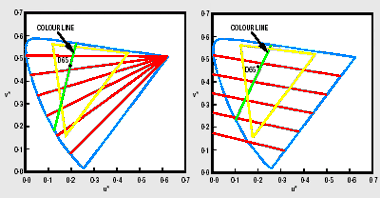|
| Allthough
various numbers exist of people who differ in |
| colour
vision from what could be considered as a standard, |
| it
can be reasonably assumed that one in twelve human |
| beings,
and most of them are males, do not perceive colours |
| as
usual. This results from the missing of (some of the) |
| photosensitive
pigments in the cone cells of their retina (see |
| 'A
short introduction in human vision biology') or
from |
| alterations
in these pigments. |
| Do
you know to which group of people you belong? |
| Watch
the next image and remember what number you have |
| seen
there before you scroll to the bottom of this page to |
| read
the answers. |
|
|
| Experiencing
a different colour vision can happen in the |
| next
page that contains a tool
for web site designers to |
| check
or to verify
the receptivity of their choice of colours. |
| |
| 'Identification'
of the various possibilities: |
| |
| Trichromat |
normal
vision using all three colours |
|
(red/green/blue) |
| Anomalous trichromat |
reception of one pigment is misaligned |
|
(anomalous) |
| Protanomaly |
reduced red sensitivity in an |
|
anomalous
trichromat |
| Deuteranomaly |
reduced green sensitivity in an |
|
anomalous
trichromat |
| Tritanomaly |
reduced
blue sensitivity in an |
|
anomalous
trichromat |
| Dichromat |
only 2 of the 3 visual pigments exist - |
|
red, green or
blue is missing |
| Protanopia |
unable to receive first colour (red) |
| Deuteranopia |
unable
to receive second colour |
|
(green) |
| Tritanopia |
unable to receive third colour (blue) |
| Monochromat |
almost
no -atypical- to none -typical- |
|
colour
vision (black & white vision) |
|
|
|
|
| Some
spectral examples: |
|
|
 |
|
|
| With
respect to the colour
triangle (see 'Colours
II') the |
| lines
that indicate the colours that dichromats confuse are |
| given
below. Every colour along a given line looks the same |
| as
all other colours along that line. The point at which
the |
| colour
line crosses the confusion lines represents the |
| perceived
colour for that confusion line. |
|
|
 |
| colour
triangles with confusion lines |
| for
protanopes (left) and deuteranopes (right) |
|
|
| Here
are the answers to the test above: |
| An
individual with normal colour vision will see a 5
revealed |
| in
the dot pattern. |
| An
individual with Red/Green (the most common) colour |
| vision
missing will see a 2 revealed in the dots. |
| Interested
in doing quickly some more testing? Click
here. |
|
|
|
|